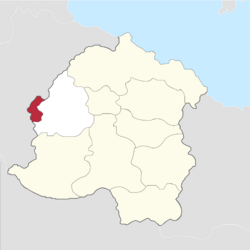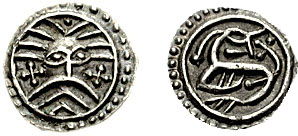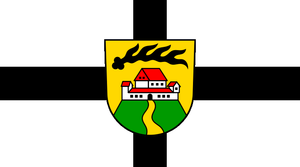Stonne (Barony)
Script error: The module returned a nil value. It is supposed to return an export table.
Stonne Barony
| |
|---|---|
 Stonne  Spelph | |
 Location of Stonne Barony within Yonderre | |
| Nation | |
| County | |
| Consolidated as Barony | 1474 |
| Capital | Stonne |
| Government | |
| • Baron | Phillipe de Blaincour |
| • Steward | Eugen von Eichenhöh (UY) |
| Area | |
| • Total | 11,727.8 km2 (4,528.1 sq mi) |
| Population (2026 estimate) | |
| • Total | 745,651 |
| • Density | 64/km2 (160/sq mi) |
| Demonym(s) | Stonnic Stonnics (plural) |
Stonne (Gothic: Stohn) is a Barony in the County of Donne, Yonderre. It is situated at the very westernmost edge of Donne, neighbouring the Baronies Nouvelle-Torantino and Nouvion. At 11,727.8 square kilometres (4,528.1 sq mi), Stonne Barony makes up just under 8.65% of the territory of Donne and with a population of 745,651 it makes up just under 6.24% of the County's population.
The primary settlements of Stonne are the Barony's eponymous capital Stonne as well as the towns Spelph, Loneur, Nouvion-sur-Spelph and Ichêneur. Because the Barony is dominated by the vast Black Forest that it lies within, it is a major center for tourism in Donne with more than 18 million overnight stays in 2025. The northwestern reaches of Stonne outside of the Black Forest and around the Spelph River valley are dominated by the industrial complexes of Spelph and Loneur as well as the vast mining complexes of the latter. The river Spelph, a tributary of the Donne River, flows through much of Stonne and is an important waterway for the region.
Before the Conquest of Joanusterra, the lands of modern Stonne consisted of a number of smaller fiefdoms within the Grand County of Don, making up the western borderlands of the Grand County. The lands were consolidated into a Barony under Sir Prise de Blaincour in 1474. Stonne was central to the First Potato War (1556-1557) and the Yonderian Peasants' War (1641–1643), both of which caused great damage to the Barony. Stonne saw great prosperity following the industrial revolution which led to widespread deforestation and expanded mining operations in the region, causing rapid urbanization in Spelph and Loneur. Today, the region is mostly noted as a tourist destination, particularly for Yonderian holidaymakers looking to spend their vacation within Yonderre, as well as being home to five of the 100 largest publicly held Yonderian corporations by revenue.
Etymology
The Burgoignesc name for the Barony, Stonne, is derived as an exonym from the native Gothic name Stohn. The Proto-Gothic root from which this noun is derived is *steh₂- (older reconstruction *stā-) "to stand" (or "to stand up, to step somewhere, to position oneself"), which is also the source of the Julian Ænglish to stand. It is thought to refer to the Donne River, to which Stonne is the westernmost point, thus being the last stand before this natural boundary.
History
Ancient history

The lands that make up Stonne have been inhabited by humans since before recorded history, with documented cases since the Paleolithic period. The numerous lakes and tributaries of the Donne River provided ample sources of fresh water for the peoples who lived there, and the woods and caves provided shelter and building materials for the prehistoric inhabitants of Stonne.
Studies of the genetic makeup of Stonne's prehistoric inhabitants show a high frequency of the y-chromosome haplogroup G2g, a common genetic trait amongst the Gothic peoples. Khovihnihk tribes migrated from the coast of the Vandarch around the third century BC, settling a town where the modern town of Spelph is. The Khovihniks were eventually pushed north and out of the region by the Goths during the Great Gothic migration of the seventh century AD. The ancient Khovihnik ruins in Spelph are now a tourist attraction.
Medieval Stonne

Although written sources from medieval Gothica are rare, it is known that the town of Stonne recieved market town privileges from the Grand Chief of Don around 780, although the exact date is disputed. Dan Lärdmann attests in his Chronica Gothica from the late 9th century that the holdings of Stohn and Spelf and their surrounding lands were under the rule of Ingmar the Ironwilled, who had sworn fealty to Grand Chief Ricfried of Don. In 952 Chief Ingmar the Ironwilled completed the construction of a castle atop the dominating hill of the town of Stonne. Slag heaps found in western Stonne indicate that silver was being separated from lead in the Spelph River valley around the late ninth century as well. Black Forest silver was mined mainly in Loneur and transported to Stonne for minting into coins.
Stonne as a region became widely traveled in the tenth century as a crossroads between eastern and western Gothica. The region prospered in this period, with the town of Stonne competing with Donburg economically, culturally, and politically. The Counts of Stonne enjoyed great respect in Gothica at large and profitted handsomely from the silver mining. The region changed hands a number of times, either from sale or conquest, belonging at various times either to vassals of the Grand Counts of Donne or directly to the Grand Counts himselves.
Stonne after the Crusades

Stonne was captured after only light skirmishing in 1474 towards the very end of the Conquest of Joanusterra. Following the crusader takeover, Sir Prise de Blaincour became the first Baron of Stonne, reinforcing the castle atop Stonne Hill to solidify his control over the town. The Prokopites, a Catholic monastic order, formed in Stonne in 1488. Construction of Stonne Monastery began in 1488, funded at least in part by Baron Prise de Blaincour and his lord Steward Falco d'Agostino. The Prokopites soon became the dominant religious authority in Stonne and sought to appease the local Goths by bridging the gap between Catholicism and the local East Gothic faith, reinterpreting local folklore and tales into a Christian view. This caused the Prokopites criticism from the Bishopric of Donne but did not hinder their preachers, and as a result, Stonne and the surrounding lands experienced a much smoother transition to Catholicism than many other regions of Yonderre.
A tally of his holdings ordered by the Steward of Donne Rachet d'Agostino in 1520 shows Stonne as a wealthy Barony; the town of Stonne itself was home to a church, a butchershop, a watermill, a common blacksmith, a swordsmith, an armoursmith, two tailor shops, a grocer, three inns, a bakery, a cobbler, two glassmakers, two tanners, an apothecary and a bathhouse. Stonne Monastery boasts in the same tally it's own water mill, blacksmith and butcher. Apart from a studdery, blacksmith, butchershop and tanner, Spelph is especially noted for the presence of several tower mills that were used to efficiently grind grains from the nearby farms.
A record from 1531 shows that an angry mob lynched a charlatan in Stonne town when the latter had sold made-up remedies as cures for anything from common cold to plague. The town's Bailiff, Gregor, was killed too when he attempted to intervene. Although nobody was physically punished for the activities of the lynch mob, Baron Rocher de Blaincour levied an extra tax on the town for the next five years for the killing of the Bailiff. Similarly, an elderly hermit was killed in 1535 when her home in the forests north of Spelph was torched by a mob amid rumours that she was a witch, accused of having cursed the cattle of Spelph to lactate sour milk. A serial egg-thief, a charcoal burner who lived alone in a hut on the banks of the river Spelph, was murdered with pitchforks in another grizzly display of mob justice in 1536. The upgrade to a watchhouse from a simple catchpole helped alleviate the issue of vigilante justice as criminals no longer had to be brought all the way to Stonne to be brought to justice.
First Potato War and Yonderian Peasants' War
Stonne was central to the First Potato War which began with the Potato movement rising up in Spelph in 1556 in protest of the import ban placed on potatoes, although the movement was also spurred on by the concurrent Great Confessional War. The movement garnered wide support and the peasants of Stonne and Spelph banded together with those of surrounding Baronies. They laid siege to Stonne Monastery briefly but failed to take it, instead opting to capture and loot Stonne Castle. The peasants of Stonne soon linked up with a likeminded band of peasants in Nouvelle-Torantino and marched on Donnebourg. Although the peasants were defeated the following year far outside Stonne, the repercussions of the diminished workforce was felt in the region for generations to come.
The town of Stonne was partially destroyed during the Battle of Stonne that decisively ended the Yonderian Peasants' War in 1643 when the Black Host of Fabian Löwenschiold made their last stand there. Houses damaged beyond repair, mostly due to fires caused by the battle, were demolished and replaced with contemporary renaissance buildings, while those that could be repaired more easily were preserved, notably the church and castle. The defeat of the peasant army drove many of its former members to banditry, making the Black Forest and Stonne in particular rife with highwaymen and brigands. Despite a concerted effort by the Counts of Donne the problem persisted until the turn of the century.
Industrial Revolution and modern period


Stonne was at the heart of the industrial revolution in Yonderre. For several centuries logs from the Black Forest had been rafted down the Donne River via the Spelph River for use in the shipping industry, as construction timber and for other purposes. This branch of industry boomed in the 18th century and led to large-scale clearances and major deforestation. The takeoff stage of economic development came with the railroad revolution in the 1840s which opened up new markets for local products, created a pool of middle managers, increased the demand for engineers, architects and skilled machinists and stimulated investments in coal and iron. With the expansion of the railway and road network as alternative transportation, rafting largely came to an end in the late 19th century. The Black Forest supplied raw materials and energy for the manufacture of forest glass, primarily made in and around Stonne.
Until around 1800 the guilds, the landed aristocracy, the churches and the government bureaucracies maintained many rules and restrictions that held entrepreneurship in low esteem and gave little opportunity for them to develop. From the 1800s and 1810s a new focus on agriculture based on sugar beets, turnips and potatoes that yielded higher crops was introduced, which enabled a surplus rural population to move to industrial areas. In 1800 the population was predominantly rural, as only 10% lived in communities of 5,000 or more people, and only 4% lived in cities of more than 50,000 people. After 1815 the urban population grew rapidly due to the influx of young people from the rural areas. Particularly Spelph and Loneur grew in this period, with Spelph overtaking Stonne as the most populated city in the Barony by the 1840s.
The Beauregard Steel Works was built in the Spelph River Valley in 1841, the largest factory in Yonderre until construction of the Fabrique de Sainte-Catherine. The Beauregard Steel Works became Yonderre's leading manufacturer of steam locomotives thoughout the 1840s and 50s. A long stretch of railroad was laid to connect the steel works with Stonne, from where it connected to Donnebourg and Yonderre at large. This caused a rapid growth of industry in the Spelph River Valley, with the majority of the workforce living in the nearby town of Loneur.
Administration and politics

| District name | Population |
|---|---|
| Spelph | 122,871 |
| Stonne | 88,242 |
| Loneur | 66,423 |
| Nouvion-sur-Spelph | 58,712 |
| Ichêneur | 53,982 |
| Falcsberc | 47,205 |
| Dircsbruck | 44,217 |
| Ouldendorphe | 43,698 |
| Wolfsberc | 41,827 |
| Temwalde | 38,594 |
| Saltsenne | 36,201 |
| Ferreaux | 30,091 |
| Gorre | 28,905 |
| Baine | 25,781 |
| Rolduc | 18,902 |
Stonne is administered by locally elected Stewards and divided into the five urban districts of Ichêneur, Loneur, Nouvion-sur-Spelph, Spelph and Stonne, as well as the ten rural districts Baine, Dircsbruck, Falcsberc, Ferreaux, Gorre, Ouldendorphe, Rolduc, Saltsenne, Temwalde and Wolfsberc. Elections are held every five years. In adition to the urban and rural districts, the Spelph River Valley, Stonne Barracks and Stonne Monastery make up a further three Special Districts. The Spelph River Valley industrial region is overseen by a joint commission from the five urban districts, Stonne Barracks is administered by the Yonderian Defence Force and Stonne Monastery is overseen by the Order of Saint Prokop.
Stonne has a natural boundary in the west and north via the Donne River. Stonne's southern and eastern borders with the Baronies of Nouvelle-Torantino and Nouvion are clearly defined in the Constitution of Donne and follow the pre-existing boundaries of farmsteads and natural features such as streams.
Demographics
As of the 2026 Donne Popular Census, Stonne is home to 745,651 people, giving the Barony a population density of 64/km2. 390,230 or 52% of the Barony's total population live in the five urban districts while the remaining 355.421 inhabitants live in one of the Barony's ten rural districts.
Economy
Mining
Mining is and has been historically very important to the Stonne region. Organized mining has been known in Stonne since at least the Bronze Age and continues to this day. Small liquid magmatic deposits of nickel-magnetite gravel in norite are mined and prospected in Stone. An important mining area is the Spelph River Valley and its side valleys in which many pits of coal, steel, baryte, cobalt and Black Forest silver of many kinds are mined.
Forestry
For several centuries logs from the Black Forest were rafted down the Donne River for use in the shipping industry, as construction timber and for other purposes. This branch of industry boomed in the 18th century and led to large-scale clearances and major deforestation. With the expansion of the railway and road network as alternative transportation, rafting largely came to an end in the late 19th century. The timber resources of the Black Forest provided the basis for other sectors of the economy that have now largely disappeared. Charcoal burners built their wood piles in the woods and produced charcoal which were important for the glassmaking industry. The Black Forest supplied raw materials and energy for the manufacture of forest glass.
Tourism
One of the major industries of Stonne is tourism. It is assessed that there are around 60,000 direct full-time jobs in the tourist sector and that there were around 18 million tourist overnight stays in 2025. In Spring, Summer and Autumn an extensive network of hiking trails and mountain bike routes enable different groups of people to use the region. For the winter months, skiing facilities are available in several places in the Black Forest.
